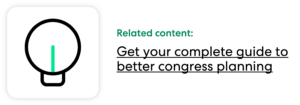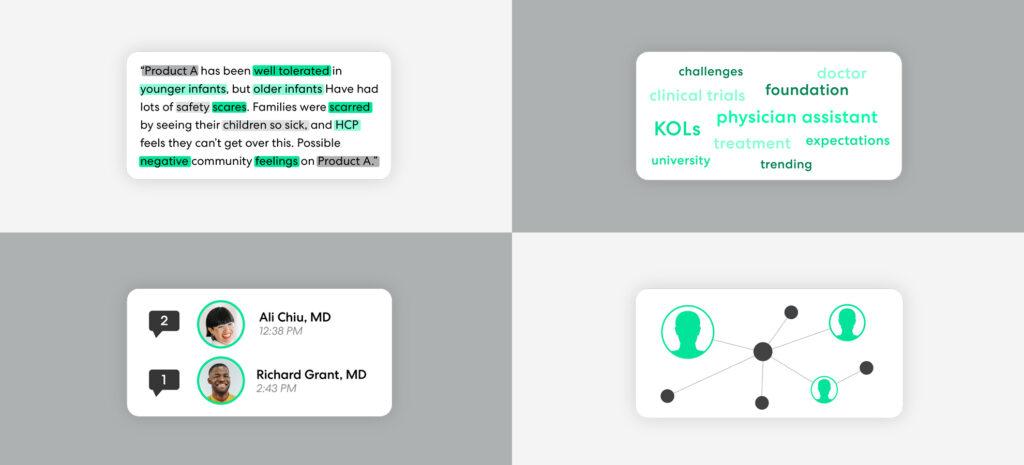A medical congress is a large, annual meeting within the life science industry where HCPs and drug and device developers exchange learnings and research. A medical congress is a multi-day medical event with various session types offered to diverse attendees. These can include KOLs like physicians and other HCPs, researchers, medical affairs teams from pharmaceutical and medical device companies, medical science liaisons, and other stakeholders in the life science industry.
What makes a medical congress so valuable to attendees?
The primary value of a medical congress is the sharing of information essential to developing life science advances, and toward the best business decisions regarding their eventual use. Keeping up with the latest in industry standards and best practices is crucial — live presentations and ongoing discussions with other opinion leaders lead to a clearer understanding.
A medical congress provides a unique opportunity, too, for people to establish themselves and build their reputations as opinion leaders, as they meet and exchange ideas with other key global stakeholders. And while these events are valued for the opportunity of face-to-face interaction to build relationships with different people, the COVID-19 pandemic changed how medical congresses connect people. While some of these changes will endure, others will evolve as life science organizations navigate the ongoing global health crisis.
What is a medical science liaison, and what do they do at a medical congress? Medical congresses offer different experiences for a medical science liaison vs. medical affairs teams. Medical science liaison challenges at a medical congress mostly consist of maximizing the value of a relatively short time. To get the most value from these annual events, MSLs should do the following:
- Watch speaker videos ahead of time to help plan which sessions to attend
- Select sessions outside your area of expertise
- Set up meetings with KOLs ahead of the event
- Ask KOLs to introduce you to their colleagues
The medical congress tradition in transition
Medical congresses were primarily in-person events until digital technology permitted some sessions to be held virtually, providing a hybrid option for attendees. With the arrival of COVID-19, though, many organizers chose to either postpone or hold the congresses exclusively as virtual events.
In a 2020 survey, some HCPs expressed doubt regarding these all-virtual events’ effectiveness. Though initially challenged by the lack of personal interaction, many of these HCPs said they expect medical congresses to be live-virtual hybrids from now on. This aligns with the shift in how many industries will present in-person events and meetings as people are more selective about when and how often they will travel.
All industries experienced an enormous shift with the times and circumstances. Change is disruptive and in the past few years, profoundly so. But from change springs innovation – and the life science industry is discovering that augmenting in-person events like medical congresses with virtual elements can expand accessibility and inclusion while increasing the quality of scientific exchange.
What’s the role of insights management in medical congresses?
When COVID-19 forced many congresses to go virtual, life science groups learned that while in-person interaction is always valuable, virtual elements can add even more value to congress events and increase the inclusivity of the meeting as well as the diversity of attendees, which can range from health care professionals like doctors to pharmaceutical companies. For years, some organizations have offered to record and stream virtual medical conference sessions for on-demand viewing and live webinars. The option to participate via a live video stream and interactive Q&A or chat is a natural extension.
Asynchronous engagement at a medical congress
The future of in-person event planning was unpredictable during the pandemic. The return to more face-to-face communications now includes many options for congress planning and attendance – a full-on virtual event, hybrid event in-person and virtual events and even all-virtual attendance tracks are in the future for medical congresses. Advantages of this shift include lower travel expenses, the convenience of access to events from anywhere, and the ability to cover more aspects of the event. More people can attend when a virtual option is available, and less disruption will occur if speakers and other participants can’t physically attend at the last minute.
How to use social listening at a medical congress
Social listening capabilities are often included within insight management platforms. These applications give pharma teams the ability to analyze online conversations before, during, and after the event, with the following advantages:
- Ability to track trending topics ahead of the event
- Monitor chatter around competitors
- Understand the difference between online conversations and discussions on the event floor
- Determining what topics generate the most interest once congress concludes
Teams can also use congress social listening to track congresses yearly and understand how conversations change and develop over time. This could include monitoring chatter around competing brands, tracking top influencers, and other topics of interest. (Related: read a client success story about social listening at a medical congress.)
Within3’s virtual advisory board capabilities within an insights management platform offer life science companies the opportunity to engage with stakeholders more efficiently and with greater frequency, including before, during, and after medical congresses. Virtual elements can better use attendees’ time in the planning stages or during the congress and extend the value of physical events after they end. One example is congress huddles that can accommodate more immediate discussions among attendees about topics brought up during the main medical event or presentation.
Learn more about how virtual elements add value to in-person medical congresses on our blog.







